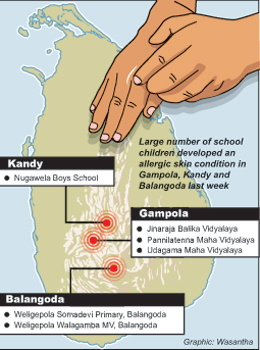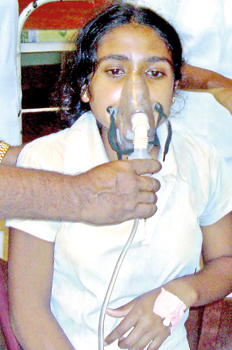News
Real or psychological, what ails these students?
= Cleanup operations launched in the premises of the five affected schools
= Doctors say some students showed symptoms of mass hysteria more than any physical symptoms
What has hit schoolchildren in different parts of the country? This is the question that is worrying parents and puzzling epidemiologists as 1,500 students of five schools have fallen ill due to allergies
The premises of the affected schools are being cleared with the assistance of the relevant councils, school authorities and parents.
School authorities of Jinaraja Balika Vidyalaya, in Gampola, where the most number of children were affected, said, it was doubtful whether they would be able to re-open the school for classes after a three day closure since Wednesday.

The Gampola Urban Council, Army and parents of students were involved in the cleaning up operations. Gampola hospital Director Sarath Weera Bandara told the Sunday Times that around 1000 students were brought to the hospital for treatment on Wednesday, November 14.
“Around 900 students of the Jinaraja Balika Vidyalaya were sent home following treatment on the same day. Around 160 of them needed further treatment since their condition was slightly more serious than the others,” Dr. Weera Bandara said.
The principal P. G. Pushpakanthi told the Sunday Times that five teachers were also afflicted by the allergy.
“The students and the teachers of one of the buildings of the school came down with this allergic reaction. It started on Friday (November 9) when eight students were taken to hospital on complaining of a skin irritation. On Monday (November 12) 12 more students were taken for treatment following a similar irritation,” Mrs. Pushpakanthi said adding that the number gradually increased.
Gampola Urban Council Mayor Sarath Gamini Hettiarachchi told the Sunday Times that the Council had initiated a campaign to clean up the premises and the school should be able to resume studies tomorrow.
Meanwhile on Thursday (November 15) 40 students of the Pannilatenna Maha Vidyalaya, 15 km away from Gampola, were admitted to the Pannilatenna rural hospital and 40 students of Udagama Maha Vidyalaya, in Gampola were admitted to Udagama hospital for the same reason.
Some of the students who were sent home after initial treatment had to be once again taken to hospital because of fainting bouts and complaints of headaches. Some of them had broken out in skin rashes too.
Udapalatha Health Medical Officer Dr. J. M. Jayasundara said they are investigating whether the allergic reactions were caused by some reaction to some airborne chemical substance or mites.
“We are trying our best to come to a conclusion regarding these incidents. However some of the children were hospitalised for panic attacks too,”she said.
On Friday (November 16) there were more reports of students from other parts of the country showing similar symptoms. Sixty students of the Somadevi Primary school of Weligepola, Balangoda and more than 60 students from Walagamba Maha Vidyalaya were hospitalised while more than 200 students of Nugawela Boys’ School, Kandy had shown symptoms of allergic reactions. Fifty of them were admitted to the Thiththapajjala hospital
Meanwhile Kandy District Medical Officer, A.G.J. Bandara, told the Sunday Times that since 9 a.m. (on November 16) students were brought to hospital with complaints of skin irritation and breathing difficulty.
“150 students were treated at the OPD while 50 were admitted. About five of them had fainted as a result of the allergy,” he said.
Central Province Health Director Dr. Shanthi Samarasinghe said the affected students were treated and sent home.

A student from Gampola receives oxygen
“The allergy was present only for a day and the rashes disappeared when the children were treated with simple medications for allergies. But we keep them under observation for a couple of days mostly because this is an alien allergy and we are not sure of the course of medication for it.
“There were few cases where some students fainted and there were also instances when the students vomited but we still couldn’t come to a conclusion regarding the factors that caused these reactions,” she said.
However, she added that about 80% of these students sought treatment following panic reactions. “We couldn’t find any signs of rashes but they were complaining of symptoms which we believe could have been psychological,” she said.
She also added that blood samples taken from some of the students were sent to the MRI (Medical Research Institute) for investigations.
“As precautions we have instructed the principals to keep the school premises clean and to take the students who fall sick immediately to hospital,” she added.
A senior official of the Epidemiology Unit told the Sunday Times that they are yet to find answers to what had caused the allergic outbreak.
“We have taken dust, food and water samples of the affected schools for further investigations. We also suspect that these conditions were results of panic reactions which are more psychological based,” he said.
He said investigations conducted so far have shown there was no basis for an allergic reaction in these schools.
Meanwhile Dr. Harischandra Gambheera, a psychiatrist attached to the National Institute of Mental Health, Angoda, explained that there was a possibility that these symptoms could have been the result of Dissociative State also referred to as mass hysteria.
Dr. Gambheera said this was common among children especially girls and that it could spread among a group, all complaining of similar symptoms. He also added that children showed similar symptoms to allergic reaction to pollen).
Additional reporting by Suranga Rajakaruna in Gampola
Follow @timesonlinelk
comments powered by Disqus


















